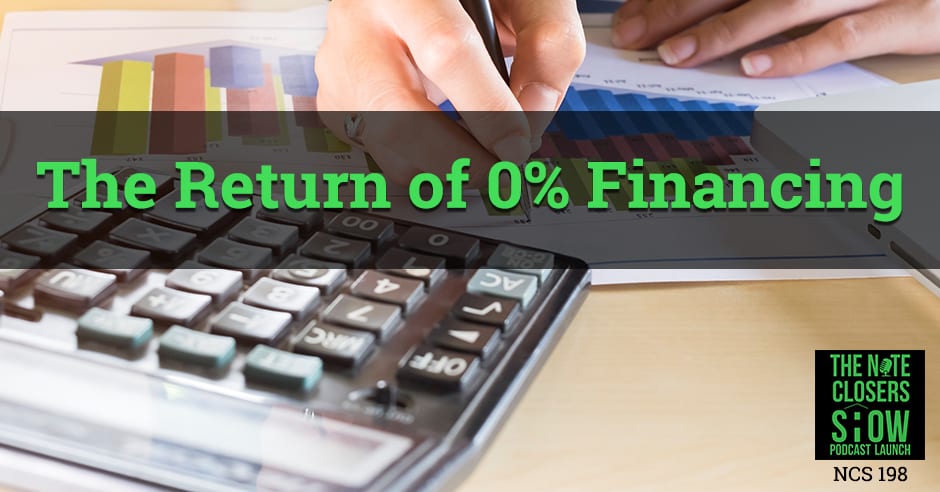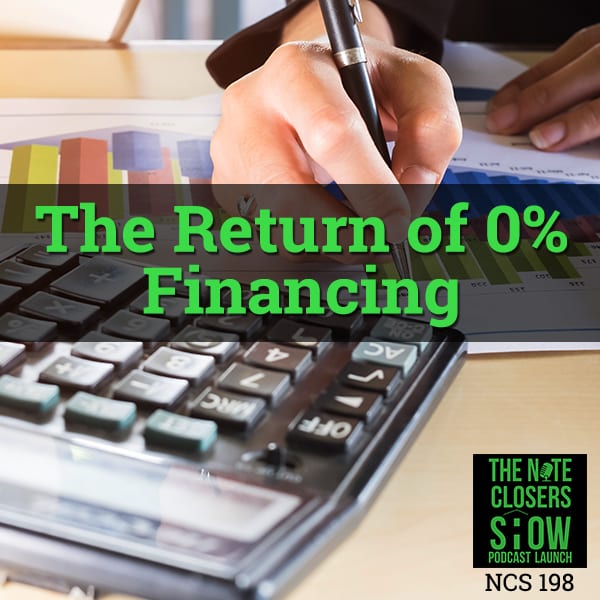
One nature of a lender is to come and take advantage of an opportunity. Banks will always find ways to capitalize on their profits and one way is through zero percent financing. As the number of loan officers increase, homes with a $500 down payment will also increase. Study the patterns of how history is repeating itself with people getting homes that they really can’t afford in the long run.
—
Listen to the podcast here
The Return of Zero Percent Financing
Today’s episode is going to be about something, a news article that HousingWire put out there about how Flagstar Bank is rolling out a zero percent financing loans to credit challenged borrowers. Is this a good thing or is this a bad thing? I sent an email out and it went out to our database about how this is a very significant domino, a very big domino when you have banks starting a zero percent financing again to credit challenged borrowers. Plus, they’re also providing down payment assistance for free where Flagstar is gifting up to $3,500 down towards an NFHA loan or $3,500 down payment, and then 1099-ing the borrowers where they don’t have to pay it back but they do get taxed on it at the end of the year. Why is this so significant? A couple of things. Just so you know, Flagstar lends in Michigan and they’re doing this program initially in eighteen counties around where they’re located in Michigan. Flagstar has a lending presence in Arizona, California, Georgia, Indiana, Kentucky and Nevada besides just Detroit. What’s this mean? If they’re lending out just locally, it’s probably a pilot program but they’re going to roll out across their whole footprint.

Zero Percent Financing: There’s no obligation for the borrowers to qualify to repair the down payment.
A couple of things from the article that come out. There’s no obligation for the borrowers to qualify to repair the down payment. FICO score is at a 640 range, which is not the greatest. It’s not the worst but it also is not the greatest. What’s funny is that the values of these homes can exceed $120,000 in values. There’s going to be $120,000 or less in value. It’s not hard to find in a lot of areas in Michigan, that’s not bashing Michigan counties. Courts that interview people for the article that couldn’t buy a home before and now can afford it and their mortgage payment is half of what the rent is. The interest rates are somewhere between 4% to 4.6%, which is great. There’s nothing wrong with that. It’s just that this is not a good thing because you’ve already seen other banks that are jumping on board, a couple of other banks they are lending. Fifth Third out at Cincinnati is doing the same thing; launched the program last year, probably gets up to 3% of home purchase, maximum $3,600 to qualifying borrowers.
Fifth Third is lending in Michigan, Indiana, Illinois, Kentucky, Tennessee, Ohio, West Virginia, North Carolina, Georgia or Florida. You’re starting to see this stuff creep out across the country almost like the plague. I don’t mean this is a bad way because this means good stuff for us. It does mean good stuff for us and for the note game because you have people getting mortgages they shouldn’t be able to afford. If they can’t afford a down payment of $3,500, honestly, they should not be in a home. It’s just it is what it is. We already have a low enough savings across the country. I don’t want to say that Fifth Third or Flagstar is preying but they’re literally looking to capitalize and boost their bottom line. Why are they doing it? They’re going to get these loans or make some more loans, they’re going to package them up, they’re going to boost it off and sell it off as part of their securitization package. That happens all the time with banks. They’re just being greedy.
What’s going to end up happening is these are going to be the higher default rates. It’s going to boost default rates across the board. It’s a good thing for us as note investors, it means more inventory going forward. I’m not trying to sound Debbie Downer because it is a positive thing, but financially speaking as a whole, it is not a good thing for these borrowers. These people should not be in homes if you want to think of it as an economic speaking area. You’ll never going to find a one-arm economist who will say on the one hand, you have this but on the other hand, you have this. That’s what I’m doing. Another lending who’s lending on the zero percent financing stuff is United Wholesale Mortgage. One thing about United Wholesale, it doesn’t include the gifting of the down payment, but they are doing 100% financing.
What’s crazy is that these lenders are just the tip of the ice berg. It’s just the first card in a house of cards finance game that we’re going to see history repeat itself. You’re going to see these lenders start to roll out across their different states, which is a sizable chunk of the country already if you start figuring those states out. You are also going to see default rates go up in those areas because of these programs. What you need to do is wait around six to twelve months and start seeing. I guarantee some of these things will not only start sweeping across the country as other lenders get into it, as other lenders are standing by waiting. You are going to see more things like this happen, as more banks become greedy for profits and take advantage of the increasing property values that are going on, to try to take advantage to be more profitable.
The big thing to keep in mind is you can check out this article at HousingWire.com. I think I read in the article somewhere that the lenders have only done about $1 million in gifting. $1 million in gifting at $3,000, it’s about 300 homes. They’ve written about 300 loans on that. It’s $1 million. It’s not a huge lending portfolio for us to keep this in mind, but it’s just the tip of the iceberg is what I’m trying to get at. You’re going to see this spread out more. You’re going to see them start to drop the values as they’re attracting the clients. They may go from a 640 to 620. Trust me, it’s in the works. How do I know this? Because history repeats itself.
When I was a mortgage broker, we would see this where lenders would come in and lenders would spring up to take advantage of opportunities. A lot of people keep thinking things are going to go up. That’s not always the case. If you’re a traditional real estate investor right now and your property is accelerated, I would not be going in refinancing to pull that equity up, unless you’re planning on selling the house. Most of the time, the refinances have a pre-payment penalty of two points in there if you sell within two years. For me, if I had a lot of real estate that had appreciated that I actually own the real estate and have the notes, I would do a refinance or just sell the property the best as I could. Just get the property sold and pull your cash out and hold on to it. I guarantee it, in the next 12 to 24 months when these markets are to go south again or default rates are to go up on this program or other programs the banks have, it’s going to lead more inventory for us and you can start seeing the dip again. It’s going to be like a wave where you have to drop in Michigan and it’s going to spread across the country. What’s really discerning is if one of these banks does roll it out completely across their platform. If Flagstar really does roll out to Arizona and Nevada, one of those states, you are going to have a lot of people buying houses that they probably can’t afford. It’s overpriced houses. You have the same thing, so when you buy a house for $300,000 to $400,000 putting nothing down, when it’s really only probably $150,000 to $200,000 value.

Zero Percent Financing: These kinds of loan programs are going to feed product for the next three to five years.
It is an interesting timeframe to be doing this. What is going to happen? These kinds of loan programs are going to feed product for the next three to five years to note investors like myself and those that are listening on the podcast. Always make for an interesting timeframe. It’s always funny seeing comments come back, “What is it up to you to decide or to comment on banking practices?” I’m like, “I’ve been there on both sides.” Once the guy is helping to originate this stuff, as far as doing loans because the bank has loan the payment and then we do that, it is not going to make money on that. I’ve also been on the other side, where we’re buying stuff and people are getting upset because they’re going to be foreclosed or evicted, but they have no skin in the game. When you make a loan and a borrower can buy a house with no skin in the game, no down payment, there’s no motivation for them to stay in the property. Once the go default, “Why should I pay? I don’t have anything in the game. I’ll just move out. I just go rent a place.” You’re going to see that happen as well.
Let’s talk about some of the implications on these. We did some basic economic numbers on the Note Night in America webinar talking about how loan officers are increasing, number of originators are increasing across the country and you’re going to see a lot more that you can dive into this. You’re going to start seeing the billboards popping up in more places than one about being able to buy a home with $500 down or $1,500 down. We’ve already started to see this stuff. When you start seeing in seven, eight, nine, ten states especially when you have lenders lending in Michigan, in Ohio, in Illinois, those are the Rust Belt states. Medium home price in there is well-below whereas in Texas, especially California and Florida but you have people getting homes that really don’t have the financial savvy. I’m not calling them stupid. It’s just that they don’t teach finance anymore. They don’t teach budgeting. They don’t teach balancing a check book. They don’t teach all the things that come with homeownership.
Let’s talk about tax shock really fast because that happens to a lot of new home buyers. A house gets built in development. For one year, it’s taxed. The first year is taxed off of just lot values. You bought a house, you get in, you’re excited. You budget, “I can budget this. The taxes are this much.” In year two, the property gets reevaluated for not only the lot but the structure that comes with it. Your tax bills will quadruple oftentimes because it’s improved. Now, you’re payment no longer fits into your budget.
This happens just on new built. If you’re buying an existing property, they’ve got the tax basis in place, fine. We see a lot of that happen, people default a new house in communities because the taxes go up. They were just budgeting for the mortgage payment and insurance and low taxes. Now, they’re in default for the first twelve months or six months, depending on when a tax value comes through. That’s not a good thing. If you have zero skin in the game from a borrower, you are very likely to default at some point. The more you put down coming from the mortgage side and the financial advisor side, the better off you’re going to be. Having zero down, zero skin in the game is not a good thing. It’s a bad equation with no real answer to it for success in the long run. You’re going to have a few situations with people, they’re going to afford it because they’re supposed to be paying $800 in rent and now they’re paying $450. There are so many other things that go along with the house in maintenance and HOA fees and other things. Furnishing, a lot of people go out and spend money on furnishing and forget, “I’ve got to pay the mortgage payment.” They just don’t seem to get the aspect of that. In some cases, it’s a good thing but in overall long-term, honestly, it is not a good thing. It’s not a good thing but it’s a good thing for us note investors. We might see something immediately happen now. I’m doing a bet, if Flagstar can’t sell these things off or United Wholesale Mortgage or Fifth Third can sell them off fast enough, you’re going to see some good things.
We’ve got a question, “Is there any information on the gross income payment ratios they are using to approve these loans?”
One of the things you have to look at is usually mortgage brokers or banks aren’t going to go above 38% debt-to-income ratio. This means they’re going to take your debts where you’ve got to pay monthly and divide that by your income monthly. I’ll give you an example. If your debt is $400 a month and you’re only making $1,600 a month, that would be a 25% debt-to-income ratio. They don’t want you to be above 38%. Usually a 38% to 41%, 43% ratio. That means 38% on the frontend, 43% in the backend. You can’t be above 38% now and they don’t want you to see 43% once you’ve bought the loan and restructured the payment on that stuff. That’s very easy to take a look at.
The annual income is going to range basically from $35,000 to $62,000 for these borrowers who are going to qualify for the zero percent down and the borrower assistance. Borrower assistance program has been around, a lot of cities have done things like that back in years ago. When I bought my first house, I still had to bring some money on the table. I had to bring in close to $5,000 in closing cost and things like that but we’ve got 100% financing. We had an 80-20 mortgage, an 80% first and a 20% second. One was with Chase or Wells Fargo or Countrywide and the second one was with Chase or Bank One. We did that to avoid having them pay private mortgage insurance.

Zero Percent Financing: Appreciation goes up but it can’t keep going up. It’s got to be there level off or start taking a dip.
With these homes, the sales price of the homes ranging from $80,000 to $175,000 to make up for that $35,000 to $62,000 income. Those are obviously properties that don’t fall in the contract for deeds. Those are the ones that are going to be true first liens. The thing to keep in mind if you’re salivating like I am in some cases, Michigan should be a target state for you over the next three to six years to buy a non-performing debt on it, as long as the values are maintained. It’s beautiful to see what’s happening in Ohio, happening in Michigan, Indiana with Job Rowe and things like that, Illinois. That’s great. Appreciation goes up but it can’t keep going up. It’s got to be there level off or start taking a dip. I see these things, I get excited but I just shake my head. It is the beginnings of the big bang or the big short all over again. I always like to say it’s like a release of the kraken. When lenders start to do things like this, it’s like releasing the kraken.
With these kind of loans, you’re not going to be buying directly from a hedge fund later on. You’re probably going to be buying directly from a bank. How do you make those types of contacts with banks? You can use some of the basic things like LinkedIn or LandGuide for $150 to track down the asset managers and these lenders. When you want to figure out what to say or what to do, that’s just where the importance of really taking a class jumps in. We’ve got our upcoming class, December 15th to the 17th. It’s the last class of 2017. We’ve got some great stuff. We’re going to focus really heavily on making bank contacts because we really see that’s where the opportunities are going to be in 2018.
For those who don’t know, we’re almost full on our Banking Blitzkrieg aspect we talked about where we’re basically bringing twenty people in online and providing bank list for them to call. There is a cost for that. It’s not a free service. We just got a couple of spots available after looking at some things. It’s $500, four weeks of bank phone calls. It’s going to provide call blocks, call lists, the end. Once you’ve gone through the four weeks, everybody gets a list of all the bank contacts, which helps everybody out in the long run especially going in to 2018. We’ll be doing that in the later part of January through the middle of February, so four weeks of focused bank calls. We’re looking for people that can make at least 50 phone calls in a week and follow up on a regular basis. If you’re working fulltime, never done anything, never gone to a workshop, this would be not something for you to do. You would not fit in to it because you’re just going to be more of an Achilles’ heel versus actually being able to go out and make some things happen. That’s one of the things to look forward to from the Virtual Note Buying for Dummies, it’s December 15th to 17th, our virtual note buying workshop and get signed up at WeCloseNotes.com. It costs $6.99 for you and a spouse as well. We’ll be doing four to five workshops in 2018. It’s going to be the first one. We won’t have another class until February 9th, 10th and 11th. It would be the first class in 2018 for our Virtual Note Buying Workshop. By then you are a month behind already into 2018.
Just rolling these programs out, you’re going to have to give it some time before we start seeing things in the default rate. I’d be willing to bet that the default rates on these are going to start hitting higher than their normal portfolio in six to twelve months. Obviously, these institutions is banking on the fact that they can do a lot more with these lenders, can roll them into their larger portfolios. What it is, they’re just getting greedy. They’re expanding their database. It’s in the $100,000 mortgage and they’re expanding it down to $80,000. Somebody is getting greedy in that side versus thinking. They’re rolling a dice not with their money but with the bank’s money. If something goes to south, they can get billed out or sell these things off faster than they have to be around holding with our hands out trying to get things fixed at the very end.
I would not say VAs fall in the same category. VAs have very low rates and they usually require monthly mortgage insurance like the FHA and convention loans. 100% financing loans are available in 2017. Down payment assistance programs, My First Texas Home, BankRate.com. It’s not just in Michigan. You’re starting to see stuff all across the country. If I was planning for 2018, we’re going to be making a list of the lenders that are offering this 100% financing, zero percent down payment. It’s going to be something that we follow up within six to twelve months. This is how you build a platform. It’s how you build a pipeline of deals for you in the future. It’s not just right now. It’s following up with these guys in six to twelve months so you have deals in the future. You have deals come mid-May, June or July because that’s going to happen. A lot of people that are already been getting loans, what’s going to happen come December? You’re probably going to have some January defaults because Christmas is coming. I’ve got to pay for the Xbox and the big screen TV now that we have a house or the leather couches. We’re going to buy the toys to go with everything we have because we’re homeowners now. You’re going to have those default rates that roll into it.

Zero Percent Financing: It leaves you with basically nothing. You do all those work not to make any depth of return.
I would not be surprised if we see more default rates. Jen is going to have a great time come January 1st with people probably being late in their payments. We’ve already had a couple of people using stupid, shitty things. That’s the thing, keep that in mind. Keep those numbers inside. One of the great things to think about, this is why you don’t want to do skinny deals at 12% to 18% based on performance of a note. I had somebody reach out to me and said, “I am getting ready to do these deals.” They’re performing and they’re yielding about 12% yield. I’m like, “Are you using your own funds?” He’s like, “No, I’m using other people’s money.” I’m like, “Don’t do the deal then.” Because the deal is only going to return at 12% to 16% yields right now and your funding partners want half or they want a 12% or 10% return. It leaves you with basically nothing. You do all those work not to make any depth of return.
For those of you out there that are buying notes or using other people’s money, you want to make damn sure that the deals are going to return to you at least a 20% yield so if you’ve got to split that, you get 10% going to your funding partners and something coming to you, even a little bit less if you’ve got to cover a few expenses. You still want to put something in your pocket versus nothing. Don’t do a skinny deal. It is not a good thing to do, especially buying at 85%, 90% of unpaid balance. There’s not a lot of room there that does go south for you to really make any money. There’s enough there for you to get your investor’s money paid back, but this is too skinny a deal. Don’t do a deal just to do a deal. Be smart, don’t do skinny deals. Avoid the crack.
These borrowers out there, it’s mind-blowing. I’m seeing a rewind. Maybe we’re going to have The Big Short part two coming up in six years. Who knows what’s going to go on with that? Don’t get me wrong, Michigan will have done a great job re-gentrifying the cities. The Gordie Howe Bridge is being built in Detroit. Going over to Canada is a big influx downtown Cleveland, downtown Columbus. I’ve done some big things in Cincinnati, which is a great looking city. I didn’t get a hit as heavy as some of the other cities there in Ohio like Dayton and Akron and things like that where you’ve got foreclosures left and right. You do have a lot of opportunity, you just got to be careful that you don’t take a bite from every pie. Sometimes there is a poisoned apple sitting out there.
Let’s talk about these departments. What happens when a loan gets originated, you mortgage from the origination side and it rolls over to the portfolio side afterwards? On the portfolio side, the special assets or the secondary marketing department is looking. Usually their offices are in the same building right next to the pricing desk. A pricing desk is going to look at the programs available out there from the competition and try to adjust their platforms or adjust their qualification, whether it’s FICO, down payment, LTV, things like that to make it the most affordable for what’s up. You have right now, Fifth Thirds, Flagstar Bank, they’re looking at this as an opportunity they can tap into in this area. It doesn’t mean it’s a good idea to go ahead and roll those ideas out. It may be a good short-term profitability-wise if you look at their stock prices. Their stock price is probably bumped up a little bit over the last six months. The reason is because they’ve had this influx of new borrowers coming in and new loans being done. It puts some money in the market but what happens when those loans start to go bad? I’m willing to bet that they’re planning to have these thing sold off hopefully before they have to pay the piper.
What also happens a lot of times is if you have warehouse lenders who have a warehouse loan with United Wholesale Mortgage or Flagstar or whoever, mom-and-pop mortgage bankers that if they create these loans and the borrowers go in default in the first six to twelve months, they have to buy these loans back. Another opportunity if you’re a note investor is to find out if they have any warehouse lenders, if they have a warehouse line manager for any other mortgage bankers. I guarantee they probably do. That’s a great opportunity talking to person in charge of the warehouse lines. Let’s stay Flagstar’s warehouse lines may deal with twenty mortgage bankers or 100 mom-and-pop mortgage bankers across the state or country and things like that, or making individual loans that Flagstar is buying off their lines. The minute these people go in default in six months, the mortgage banker may have to buy that loan back from Flagstar at full value. If they’re in default already, they’re already losing 5%, 10% and 15% off the face value of that loan. They may have to buy it back and it’s worth less than what they owed. It’s maybe worth $.80, $.85 or $.90 on the dollar than what they took. Now, they’re motivated to get this off their line because that’s a loan that they can’t lend out once a month on. They may take another 10% write off just to get it off their books. Somebody else will pay $.75 or $.80 on a dollar for it because they could turn around and recycle that money six to twelve times a year and make up for the lost fees. It doesn’t mean it’s a bad loan if they’re not default, but if they are in default, I would not be looking to buy that loan. I would let it sit there for three more months right on their line because somebody is a lot more motivated to take it down. We’ve had success with that with mortgage bankers in the past.

Zero Percent Financing: I see things happen again all over it did like in 2007, 2006, 2005, things leading up to where it was in 2000 and 2009.
I don’t have a crystal ball but I see things happen again all over it did like in 2007, 2006, 2005, things leading up to where it was in 2000 and 2009. The magic and the music stopped on a dime with a lot of stuff. Stay tuned for more craziness. We might even see the mortgage imploder come back. For those that don’t know, there was a website out there, it might still be around, the Implode-O-Meter. I don’t think it’s being up to date very much for the most part. This website would track lenders that were going out of business, that were imploding. It literally gave a list of all these lenders down at the bottom. I want to say Flagstar was on this list originally. A lot of these lenders I bought loans from before they went out of business, or I bought from the corresponding bank that bought them. It’s an interesting website.
It was one of the great things that we used to focus on a little bit when I was teaching because there were so much stuff going out of business. They attract international banks. They attract who went out of business and who came back. I think Flagstar Wholesale was on this list originally, which is a branch of it. What I’m trying to get at is you start to see some names reappearing on this. You start seeing banks rebrand themselves a little bit once they’ve had to kill off, bring another one back as they start diving into it. HSV Mortgage Services, I see them on here. Some of these banks I haven’t seen in years because we bought from them and then they went out of business. Summit Mortgage, we bought from them. If you don’t think that there is defaulted paper on the market that you could only buy from hedge funds or list like DeadX or Auction.com, you are sadly mistaken. There is a lot of paper still floating out there and there’s going to be more of it coming. These articles are proof of it in itself. What was so great about this is they gave a watch list of lenders, like Bayview Lending Group was on their. Flagstar Bancorp, it was on the alien watch list back in the day. Nationstar went out of business and was back. JB Nutter went out of business and they’re back. Wells Fargo Canada went out of business in Canada. It’s just so interesting looking at this stuff. There are just some names on here that bring back some memories and some stuff.
That’s the biggest thing I could tell you, to take advantage of what’s happening right now. You’ve got to prepare yourselves six months from now or three months from now or the first year. What’s the best way to do that is understanding where this product is going to be and how to reach these individuals at a later date. Some of the things we’re preparing for 2018 is I would not be surprised if we full tilt and go back. This year has been basically 25% hedge fund loans and a little on a bank side. Probably more 80% to 85% from the hedge fund side of this year and a little on the banking side. This is going to be one of the focuses of the Mastermind that we’ll have, is how to prepare for 2018 and some of the economic trends that we’ve seen and lenders that we’re starting to see that are really, really same in the stage for that first domino to start falling or a big, bad wolf to come by and huff and puff and blow that house of cards down.
If you want to find more information about our upcoming workshop, it’s December 15th to the 17th. Drop me an email and we’ll be glad to send you over the link for it to get you sign up one way or another. Once again, thank you so much. We went over the 35,000 downloads, which is exciting. Not even 90 days into it rock and rolling along. Thank you so much. I want to thank all the emails that people send out to me. You can always send me an email at Scott@TheNoteClosersShow.com. Make sure to leave a review on iTunes or Stitcher. Love for you to share the episodes too if it’s something you enjoy. If it’s helped you in anyway, please do so and we look forward to continuing to expand out.
We’ve got some great guests lined up here over the next couple of weeks. You are going to definitely see some fun stuff. Hopefully we can get them scheduled in and we’ll get rock and rolling. Otherwise, go out and make something happen. We’ll see you at the top.
Important Links
- HousingWire news article
- Flagstar Bank
- Fifth Third
- United Wholesale Mortgage
- Banking Blitzkrieg
- My First Texas Home
- BankRate.com
- Implode-O-Meter
- Summit Mortgage
- DeadX
- Auction.com
- Nationstar
- JB Nutter
- Wells Fargo Canada

